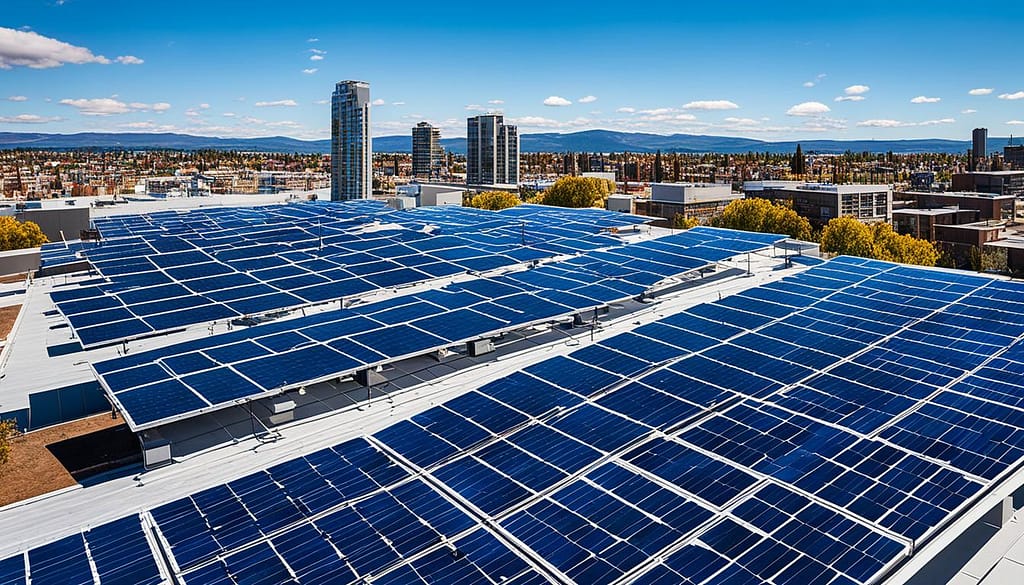Welcome to our article on solar cell construction, where we’ll explore the fascinating world of harnessing clean energy from the sun. As the world moves towards a more sustainable future, understanding the process and components involved in solar cell construction becomes crucial. By harnessing the power of the sun, we can create efficient and cost-effective green energy solutions that benefit both the environment and our future generations.
So, let’s dive in and learn more about solar cell technologies, the photovoltaic effect, the step-by-step assembly process, and the advancements in solar technology that are shaping the future of renewable energy. The sun’s energy is abundant, free, and clean – let’s harness it together!
Key Takeaways:
- Solar cell construction plays a vital role in harnessing clean energy for a sustainable future.
- Understanding the functionality and applications of solar cells is essential for optimal performance.
- The photovoltaic effect is the process by which solar cells generate electricity from sunlight.
- Choosing the right materials and optimizing various aspects of solar panel construction is crucial for energy conversion.
- Advancements in solar cell efficiency and cost-effectiveness are driving the future of renewable energy.
Understanding Solar Cell Technologies and Applications
An Overview of Solar Cell Definition and Functionality
Solar cell defination :- Solar cells are semiconductor devices that harness the power of sunlight and convert it into electricity through the photovoltaic effect. This process involves the interaction of photons from sunlight with the semiconductor material of the solar cell, producing electric current. By utilizing solar cell technologies, we can tap into a clean and renewable energy source that is abundant and available to us.
Types of Solar Cells and Their Unique Benefits
There are several types of solar cells available, each with its own distinct advantages and applications. Some common types include:
- Monocrystalline silicon cells: These solar cells are made from a single crystal structure, resulting in a higher efficiency and power output. They are ideal for installations where space is limited.
- Polycrystalline silicon cells: Made from multiple silicon crystals, polycrystalline solar cells offer a cost-effective alternative with good efficiency. They are suitable for a wide range of applications.
- Thin-film cells: These solar cells are flexible and lightweight, making them versatile for integration into various surfaces. While they may have lower efficiency, they are cost-effective and adaptable.
Understanding the different types of solar cells allows us to select the most appropriate option based on our specific needs and requirements, whether it be for residential, commercial, or industrial applications.
Applications and Quality Standards for Optimal Performance
Solar cells find application in various fields, including:
- Residential solar panel systems for generating clean energy for homes
- Commercial and industrial solar installations to offset energy costs and reduce environmental impact
- Rural electrification projects to bring electricity to remote areas
- Solar-powered agricultural irrigation systems for sustainable farming
- Solar-powered vehicles and transportation for eco-friendly mobility
To ensure optimal performance and longevity, solar cell technologies must adhere to stringent quality standards. These standards encompass factors such as efficiency, durability, reliability, and safety. By meeting these standards, solar cells can deliver consistent and efficient power generation, contributing to a greener and more sustainable future.
The Photovoltaic Effect: How Solar Cells Generate Electricity
The photovoltaic effect is the phenomenon by which solar cells generate electricity from sunlight. When photons from sunlight interact with the semiconductor material of a solar cell, they excite electrons, creating electron-hole pairs. The movement of these charge carriers produces an electric current. Understanding the photovoltaic effect is key to understanding how solar cells generate electricity.
In simple terms, the photovoltaic effect can be explained as follows:
- Solar cells are made up of semiconductor materials, typically silicon, that have unique electrical properties.
- When sunlight, which consists of photons, shines on a solar cell, it is absorbed by the semiconductor material.
- The energy from the absorbed photons causes some of the electrons in the material to be freed from their atoms, leaving behind positively charged holes.
- The separated electrons and holes are now able to move independently within the material.
- Due to an electric field created within the solar cell, the separated electrons are guided towards one side of the cell, while the holes are guided towards the other side.
- By connecting an external circuit to the solar cell, the flow of electrons can be captured as an electric current, which can then be used to power various devices.
It’s worth noting that the efficiency of a solar cell in converting sunlight into electricity depends on various factors, such as the type of semiconductor material used, the design of the cell, and external conditions like temperature and sunlight intensity.

Solar Cell Construction: Step-by-Step Assembly Guide
Building a solar cell involves several crucial steps that contribute to its overall performance and efficiency. From selecting the right materials to optimizing various aspects of the assembly, each element plays a significant role in harnessing clean and renewable energy. Let’s explore the key components and processes involved in solar cell construction.
Choosing the Right Materials for Best Solar Panel Performance
When it comes to best solar panel materials, selecting high-quality components is essential for maximizing performance and longevity. The choice of semiconductor wafers, for instance, greatly impacts the efficiency of the solar cell. Silicon, in its various forms such as monocrystalline and polycrystalline wafers, is widely used due to its excellent electrical properties and cost-effectiveness. If you are looking for cost-effective solar cell construction polycrystalline is best ooption. Other materials like gallium arsenide and cadmium telluride are also utilized in specialized applications.
In addition to semiconductor wafers, ensuring proper encapsulation materials, such as tempered glass or durable polymers, can protect the solar cell from external factors like moisture and heat, prolonging its lifespan. Moreover, utilizing reliable metallic contacts and interconnects for electrical connections is crucial for efficient energy transfer within the solar panel system.
The Role of Semiconductor Wafers in Solar Efficiency
Semiconductor wafers are the heart of solar cells, responsible for the conversion of sunlight into electrical energy. The selection of the appropriate semiconductor material is vital as it directly affects the efficiency of energy conversion. The most commonly used material, crystalline silicon, offers high conversion efficiency and stability. Monocrystalline silicon wafers, with their uniform crystal structure, exhibit higher efficiency compared to polycrystalline or thin-film alternatives.
Optimizing Doping and Junction Formation for Energy Conversion
Doping is a crucial step in the fabrication of solar cells, introducing impurities into the semiconductor material to modify its electrical properties. By carefully controlling the type and concentration of dopants, the electrical conductivity and carrier concentration can be adjusted, facilitating the movement of charge carriers and enhancing energy conversion efficiency.
Junction formation is another critical aspect of solar cell construction. The formation of a P-N junction within the semiconductor material helps create a built-in electric field, which separates the generated electron-hole pairs and facilitates the flow of current. Optimizing doping and junction formation contributes significantly to the overall performance of the solar cell.
Anti-Reflective Coatings and Electrical Contacts in Solar Panel Construction
To increase the absorbance of sunlight, anti-reflective coatings are applied to the surface of solar cells. These coatings minimize the reflection of incident light and enhance light absorption, thereby increasing the efficiency of the solar cell. Anti-reflective coatings are typically made of thin films with low refractive indexes, allowing more light to reach the active semiconductor layer.
Efficient energy transfer within a solar panel relies on proper electrical contacts. Metallic conductors, such as silver or copper, form electrical contacts that help transfer the generated current out of the solar cell and into an external circuit. These contacts should have low resistance and good conductivity to minimize energy loss and maximize power output.
Conclusion
The advancements in solar cell efficiency and cost-effectiveness are revolutionizing the renewable energy landscape. As technology continues to evolve, solar cells are becoming increasingly efficient, making solar energy an economically viable option for individuals and businesses alike.
By harnessing the power of the sun, we can significantly reduce our reliance on fossil fuels and contribute to a greener future. Solar power offers a sustainable solution that not only helps combat climate change but also reduces our carbon footprint.
Embracing green energy solutions, particularly solar power, is key to shaping a renewable energy future. With the development of innovative technologies and favorable government policies, solar power is poised to become a major player in meeting our energy needs in a clean and environmentally friendly way. By investing in solar energy, we can ensure long-term energy security and create a more sustainable world for future generations.
FAQ
What is solar cell construction?
Solar cell construction refers to the process of building semiconductor devices that convert sunlight into electricity through the photovoltaic effect.
What are the different types of solar cells?
There are various types of solar cells, including monocrystalline silicon, polycrystalline silicon, and thin-film cells, each with its own benefits and applications.
How do solar cells generate electricity?
Solar cells generate electricity through the photovoltaic effect, which is the phenomenon where photons from sunlight excite electrons in the semiconductor material, creating electric current.
Explain Step-by-step solar cell assembly
step-by-step solar cell assembly:-The key steps in solar cell construction include choosing the right materials, optimizing doping and junction formation, utilizing anti-reflective coatings, and establishing proper electrical contacts. These factors contribute to efficient energy absorption and current flow.
How can solar energy contribute to a sustainable future?
Solar energy is a clean and abundant source of power that can help reduce dependence on fossil fuels and mitigate climate change. By harnessing solar energy, we can contribute to a sustainable and environmentally friendly future.

